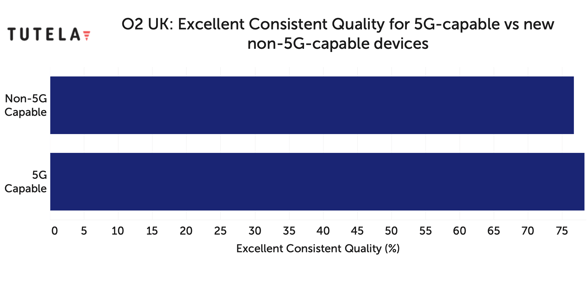June 2021
T-Mobile has had the advantage of significant already-available spectrum holdings to build out its 5G network, and the operator has taken full advantage. Using its 600 MHz spectrum — the lowest frequency available in North America for 5G deployment — the operator has been able to rapidly build out a network that is unrivalled in terms of total coverage.
However, coverage is not the real benefit of 5G. The real promise of the next generation of wireless technology is improved capacity, by using far more spectrum than is currently deployed for LTE – effectively building wider highways to carry more data, and do so faster. In order to see significantly improved speeds — and any real change in user experience — T-Mobile is also deploying large swathes of mid-band 5G spectrum acquired from Sprint.
While the future applications of 5G are hugely promising, determining the current effectiveness of 5G deployments can best be measured by looking at the impact on user experience, and particularly whether the additional capacity is alleviating the problem of network congestion. In order to do so, Tutela has collected and analyzed network tests from real-world 5G and 4G devices in ten large urban areas1, all of which have mature T-Mobile 5G deployments. The results aim to answer the question of “If I upgrade to a 5G-capable device rather than a new 4G device, how different will my experience be?”
Journalists at PCMag and The Washington Post have reported lacklustre 5G performance for different US operators, so we drew upon our 4G and 5G performance data to dig into this in detail.
|
Key findings
|
| 1 For T-Mobile, these were the following Urbanized Areas: Atlanta, GA, Chicago, IL--IN, Dallas--Fort Worth--Arlington, TX, Houston, TX, Las Vegas--Henderson, NV, Los Angeles--Long Beach--Anaheim, CA, Miami, FL, New York--Newark, NY--NJ--CT, Philadelphia, PA--NJ--DE--MD, Washington, DC--VA--MD |
The chart above shows performance of 5G capable and modern non-5G capable devices in selected 5G-enabled cities. The results are from the device-perspective and include both 4G and 5G connectivity (in the case of 5G capable handsets) in order to answer the "if I upgrade, how much of a better experience will I get?" question.
At a surface level, the answer appears to be “not very”. 5G capable and non-5G capable devices2 performed virtually the same for Excellent Consistent Quality on T-Mobile's network, Tutela’s metric for how often a connection is capable of demanding everyday use-cases, like streaming 1080p video, playing multiplayer online games, and performing a group HD video call. Simply put, the proportion of tests that were good enough to do those things was virtually identical between the 4G-capable devices and 5G-capable devices, indicating that right now, a user’s overall network experience is unchanged simply by having a 5G-capable device.
These results are likely to due to the fact that T-Mobile's 4G connectivity in these 5G locations is also very good and delivering sufficient performance for the majority of applications anyway. It is worth noting that this was not the case for other operators that we have analyzed in a similar way - O2 in the UK saw a 2.5 point increase for the same metric.

Of course, that’s not to say that T-Mobile's 5G offers no benefits at all. If we focus on 5G connections versus 4G connections, we are able to see clear differences between the network technologies.
|
2 Non-5G-capable devices were limited to those released since 2019, to ensure a fair device comparison |
Excellent Consistent Quality, Tutela’s flagship metric of user experience, is a little better when a device is connected to 5G rather than 4G. Excellent Consistent Quality considers a number of network measurements, including download, upload, and latency (among others), and is designed to answer whether a connection is “good enough” for common applications.
Download throughput, on the other hand, is a more direct measure of network performance rather than user experience, and it’s here that the greatest difference between 4G and 5G can be discerned. Median download throughput sees a bump of 25% between 4G and 5G for T-Mobile. This should come as no surprise — consumer advertising of 5G thus far has leaned heavily on speed — however it is still important to consider the performance improvement alongside this as many consumer applications do not require the peak throughput speeds that 5G can offer.
The greatest real-world difference between 4G and 5G, however, lies at the bottom of the download throughput chart, not the top. Looking at the number of throughput tests slower than 1.5 Mbps is a good indication of the level of congestion on the network, and for 5G, less than half as many tests fall below this threshold, compared to 4G.
This is made even more clear when looking at the same metric by time of day. During off-peak hours (overnight), the proportion of tests falling below 1.5 Mbps is virtually identical for 4G and 5G. But over the course of the day and into the evening — when people are using their devices — the proportion of tests failing that low threshold increases far more for 4G than for 5G, showing that for 5G, network congestion is much less of a problem.
Of course, part of this is due to the lower number of users currently connecting to the 5G network, compared to 4G; as 5G device adoption increases — something that T-Mobile is working to accelerate — network capacity and congestion may become considerations once again. But for the time being, it is clear that T-Mobile’s 5G network is doing a better job of providing users with a consistently fast-enough connection. As the 5G network becomes more ubiquitous, we would expect to see the user experience gap between 5G-capable devices and 4G devices increase; for now, however, the data suggests that 5G adoption isn’t significantly changing users’ experience overnight.
Get in touch today to schedule a demo, see Tutela Explorer in action and discover insights for your region.
